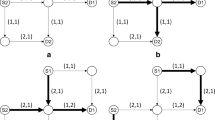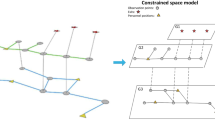Abstract
Given a transportation network with capacity constraints, the initial occupancies and the destination nodes, evacuation route planning generates a set of evacuation routes and a schedule for the movement of people and vehicles along these routes, such that the evacuation is completed in the shortest possible time. This is a critical step in disaster emergency management and homeland defense preparation. In order to avoid the large storage and calculation costs brought by the time-expended-graph for transforming dynamic network flow problem to static network flow problem, the heuristic algorithm of the Capacity Constrained Route Planner (CCRP) is researched. One defect of the original CCRP algorithm is studied carefully and the new algorithm with longer route preferential is proposed to improve it. The result of the experiment shows the feasibility of the algorithm.
Preview
Unable to display preview. Download preview PDF.
Similar content being viewed by others
References
ESRI: GIS for Homeland Security. An ESRI white paper (2001)
The Homeland Security Council.: Planning Scenarios, Executive Summaries, Created for Use in National, Federal, State, and Local Homeland Security Preparedness Activities (2004)
Brown, S.: Building America’s Anti-Terror Machine: How Infotech Can Combat Homeland Insecurity. J. Fortune, 99–104 (2002)
The Volpe National Transportation Systems Center: Improving Regional Transportation Planning for Catastrophic Events (FHWA). Volpe Center Highlights, 1–3 (2002)
Hamacher, H.W., Tjandra, A.: Mathematical modeling of evacuation problems: State of the Art. J. Pedestrian and Evacuation Dynamics, 227–266 (2001)
Chalmet, L., Franis, R., Saunders, P.: Network Model for Building Evacuation. J. Management Science. 28, 86–105 (1982)
Francis, R., Chalmet, L.: A Negative Exponential Solution To An Evacuation Problem. Research Report. National Bureau of Standards. Center for Fire Research (1984)
Hoppe, B., Tardos, E.: Polynomial Time Algorithms for Some Evacuation Problems. In: Proceedings for the 5th Annual ACM-SIAM Symposium on Discrete Algorithms, pp. 433–441 (1994)
Akiva, M.B., et al.: Development of a Deployable Real-Time Dynamic Traffic Assignment System: DynaMIT and DynaMIT-P User’s Guide. Massachusetts Institute of Technology (2002)
Mahmassani, H., Sbayti, H., Zhou, X.: DYNASMART-P Version 1.0 User’s Guide. Maryland Transportation Initiative, University of Maryland (2004)
Lu, Q., George, B., Shekhar, S.: Capacity Constrained Routing Algorithms for Evacuation Planning: A Summary of Results. In: Bauzer Medeiros, C., Egenhofer, M.J., Bertino, E. (eds.) SSTD 2005. LNCS, vol. 3633, pp. 291–307. Springer, Heidelberg (2005)
Ahuja, R.K., Magnanti, T.L., Orlin, J.B.: Network Flows: Theory, Algorithms, and Applications. Prentice-Hall, Englewood Cliffs (1993)
Ford, L.R., Fulkerson, D.R.: Flows in Network. Princeton University Press, Princeton (1962)
Kennington, J., Helgason, R.: Algorithm for Network Programming. John Wiley & Sons, Inc., New York (1980)
Frangioni, A., Manca, A.: A Computational Study of Cost Reoptimization for Min-Cost Flow Problems. J. Informs journal on computing, 61–70 (2006)
Theodoulou, G., Wolshon, B.: Alternative Methods to Increase the Effectiveness of Freeway Contraflow Evacuation. J. Technical Report Transportation Research Record. The Journal of Transportation Research Board 1865, 48–56 (2004)
Jha, M., Moore, K., Pashaie, B.: Emergency Evacuation Planning with Microscopic Traffic Simulation. J. The Journal of Transportation Research Board 1886, 40–48 (2007)
Lu, Q., Huang, Y., Shekhar, S.: Evacuation Planning: A Capacity Constrained Routing Approach. In: Chen, H., Miranda, R., Zeng, D.D., Demchak, C.C., Schroeder, J., Madhusudan, T. (eds.) ISI 2003. LNCS, vol. 2665, pp. 111–125. Springer, Heidelberg (2003)
Kim, S., George, B., Shekhar, S.: Evacuation Route Planning: Scalable Heuristics. In: Proceedings of the 15th International Symposium on Advances in Geographic Information Systems. ACM GIS (2007)
Hoogendoom, S., Bovy, P.: State of the Art of Vehicular Traffic Flow Modeling. J. Proceedings of the Institution of Mechanical Engineers, Part 1: Journal of Systems and Control Engineering 215, 283–303 (2001)
Klingman, D., Napier, A., Stutz, J.: NETGEN: A Program for Generating Large Scale Capacitated Assignment, Transportation, and Minimum Cost Flow Network Problems. J. Management Science 20, 814–821 (1974)
Author information
Authors and Affiliations
Editor information
Editors and Affiliations
Rights and permissions
Copyright information
© 2009 Springer-Verlag Berlin Heidelberg
About this paper
Cite this paper
Zeng, M., Wang, C. (2009). Evacuation Route Planning Algorithm: Longer Route Preferential. In: Yu, W., He, H., Zhang, N. (eds) Advances in Neural Networks – ISNN 2009. ISNN 2009. Lecture Notes in Computer Science, vol 5551. Springer, Berlin, Heidelberg. https://doi.org/10.1007/978-3-642-01507-6_119
Download citation
DOI: https://doi.org/10.1007/978-3-642-01507-6_119
Publisher Name: Springer, Berlin, Heidelberg
Print ISBN: 978-3-642-01506-9
Online ISBN: 978-3-642-01507-6
eBook Packages: Computer ScienceComputer Science (R0)




